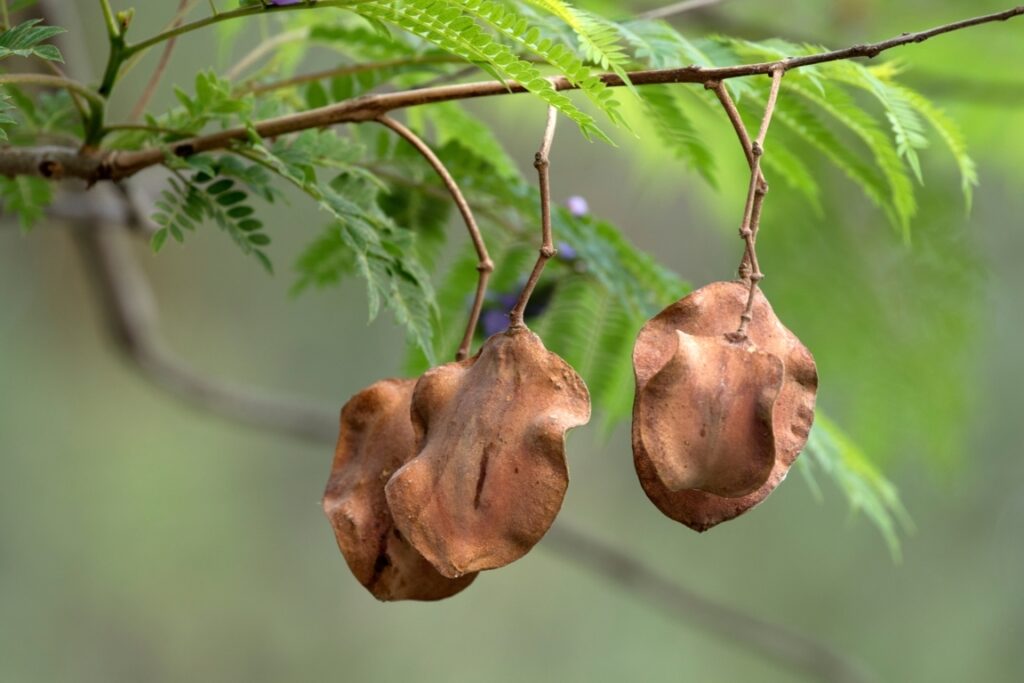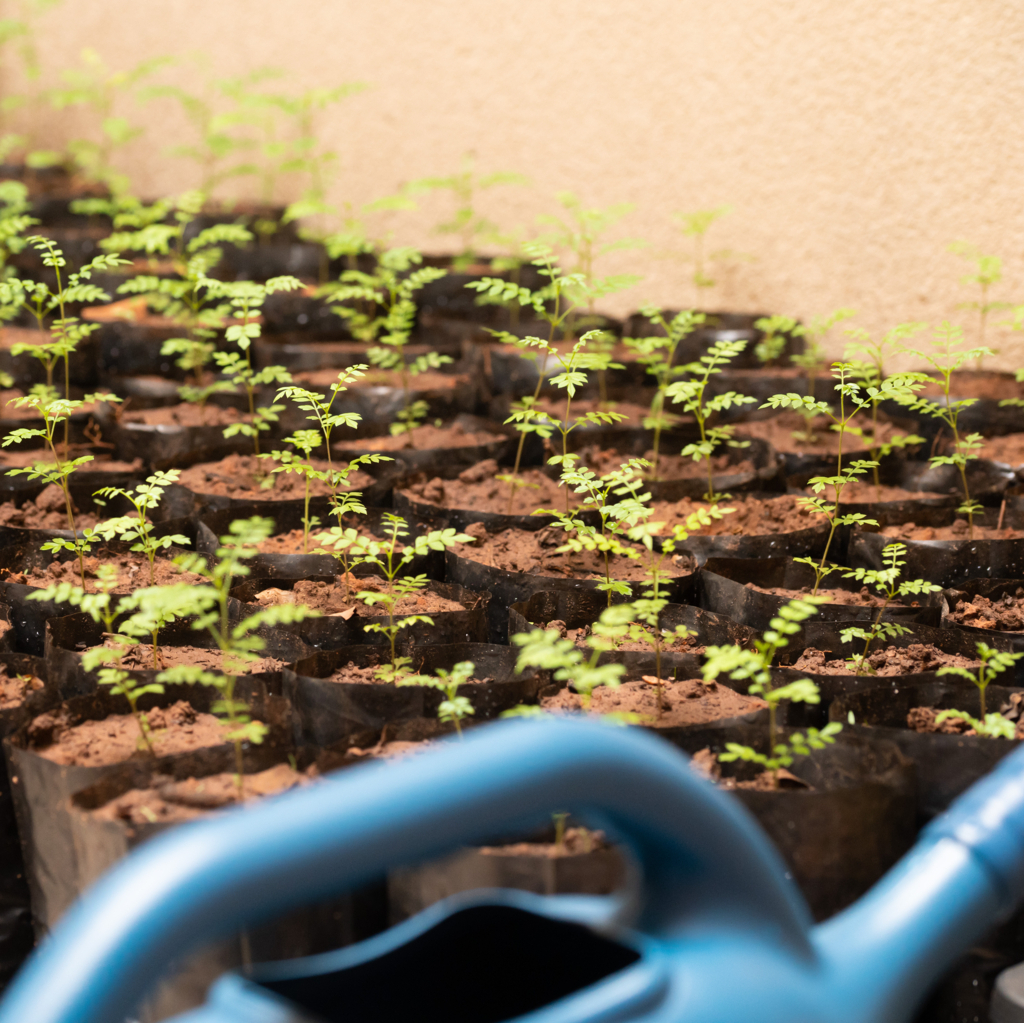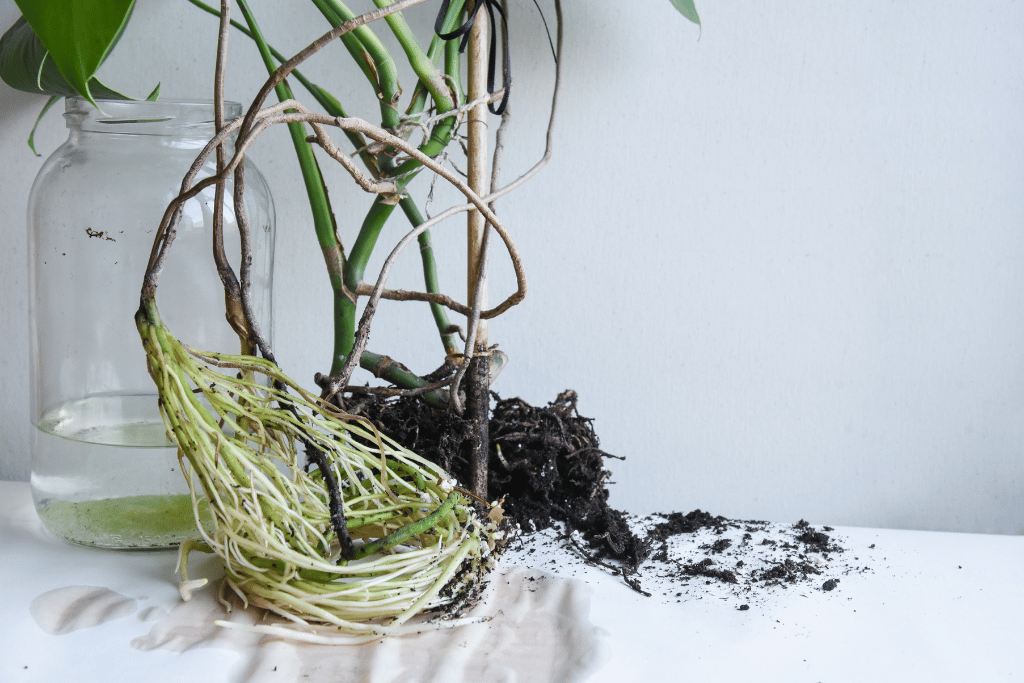Native to Argentina and Bolivia, jacaranda are deciduous trees which can grow up to 25-50 feet tall. They aren’t very cold-hardy and may require a degree of protection during winter depending on where you live. The lowest temperature they will at tolerate at night is around 5 degrees Celsius. (40F). Growing jacaranda bonsai from seed is ideally started January or February.

Collecting Jacaranda Seeds
Jacaranda trees drop their seed pods in autumn, so that’s the best time to collect them. Seed pods develop in late summer and become dry and brown – they are typically one to three inches wide.
The best way to collect jacaranda seeds is straight from the tree – the seed pods that have already dropped to the ground may have dispersed their seeds already.
Planting Seeds
Once you have your seed pods, you can begin to plant them. Open the seed pod with something sharp like a knife, and collect the seeds. When this is done, you can plant the seeds straight away or wait until January/February to sow them. I recommend waiting until January/February if you are in a colder climate, such as the UK.
To prepare the seeds, you should first soak them in water for 24 hours. Any seeds that float are likely not going to be viable, so you should separate these from the ones which sink, and you can plant them separately to see if any germinate.
After the seeds have soaked, you can then sow them into a medium such as a tray. I recommend using a potting mix composed of compost, perlite and sharp sand. This is a good mix for starting seedlings. Once you have placed your seeds on the surface, make sure to give them a bit of distance to allow them space to grow. Sprinkle a bit of the soil mix over the seeds to cover them.
Once this is done, you should keep the soil moist to ensure the seeds have enough water to germinate. Keep them at a stable temperature of around 20-24C (68-75F) and give them good light. If done correctly, then the seeds should hopefully sprout within two to eight weeks.

Transplanting Seedlings
When growing jacaranda bonsai from seed, you might find that quite a few will germinate. If this is the case and you have planted them in a tray, the seedlings are likely going to get quite crowded, and you’ll need to separate them. Repotting will give them enough space to develop their roots and eliminate competition for water and nutrients.
To prick out the seedlings, you should gently tease the seedlings out of the tray or pot. You can carefully remove a very minimal amount of soil if you’d like, but it’s best to keep the soil on until they’re a bit older. Once you have the seedling, you can plant it in its new pot.
Make sure the pot is sterile and clean, and make sure that you have a soil mix on hand to pot the seedling into. You can use the seed mix again or use another combination which is well-draining. I like to use compost for my seedings as this will usually provide them with enough nutrients for a few months until I can manually fertilize them without burning their roots. When growing jacaranda bonsai from seed, you should wait around eight months before transplanting the seedlings.
Growing Jacaranda Bonsai From Seed
Hopefully, within a few months, you should have a few jacaranda bonsai seedlings growing. If you’re taking good care of them, you might see quite a bit of growth being put on in the first few months, which is always a good sign. However, you should note that it can take around 10-20 years to develop a jacaranda seedling into a bonsai, as they can grow quite slowly and developing them can take a long time (especially if you’re a beginner).
Watering
When growing jacaranda bonsai from seed, you should note that the jacaranda seedlings will have a lower water demand than older trees. They will have a lot less roots, and therefore it will be relatively easy to kill them by underwatering or overwatering. Try and keep the soil mixture moist at all times, not soggy. If the soil mix is constantly soggy, this can promote root rot, killing the seedling quickly.
On the other hand, underwatering will kill the jacaranda seedling even quicker than overwatering. You will see the leaves start to brown, and the seedling will eventually halt its growth and die. I recommend checking the soil at least every day – you can poke your finger an inch deep into the soil to test the moisture.
Fertilizing
Jacaranda seedlings are no exception to being burned by fertilizer – I don’t fertilize any of my seedlings for a few months or even up to a year, as this can burn the roots and kill the seedling very quickly. If I fertilize the seedling early, it’ll be a diluted concentration.
The compost I use in my seed mix is typically specialized for seeds, providing them with enough nutrients to get by for the first few months without having to fertilize them manually.
For older jacaranda bonsai trees, it’s good to use fertilizers with high phosphorous concentrations, promoting the development of flower buds which may reward you with striking blooms.
Repotting
In a tray, your jacaranda bonsai seedlings will likely get very crowded within a few months. The roots will entangle each other, making the repotting process a bit finicky. It’s best to prick them out and transplant them within eight months.
If you’re already past this stage and the jacaranda seedling has been growing in its own pot for a few months, you should be okay. However, in around a year or two, you might find that the seedling is becoming root bound. This is where the roots don’t have enough space to grow, so they start to circle around the pot and come out of the drainage holes. When this occurs, it’s best to repot them, ideally in the spring.
Your seedling will now need a larger pot but it’s not ready for a bonsai pot, as this will restrict the growth.You can also plant the seedling in the ground to thicken the trunk a lot quicker. However, you’ll still have to develop the branches and ramification of the tree.

Wiring
As with any other seedling species, I don’t wire my jacaranda bonsai seedlings in their first year. I let them grow uninterrupted for their first year, allowing them to get established and put out a bit of growth. If you wire them immediately, this can damage the seedling and might slow down or halt growth.
Past their first year, I’ve found that seedlings should still usually be able to be bent with wire, and if not, you can apply a higher gauge. However, you should still only be using around 1.0mm or 1.5mm for seedlings – they likely won’t require any more. Too high of a gauge will bite into the bark quickly.
It’s good to use annealed aluminum wire with seedlings, as this is relatively easy to work with and cheap. Using copper wire for seedlings can be a bit overkill, and it’s pretty stiff to use, which isn’t suitable for tiny seedlings.
Further Reading
By now, growing jacaranda bonsai from seed should hopefully be a straightforward process for you! If you’re still unsure about caring for the jacaranda after it has germinated, you can check out this article in which I discuss the general care of seedlings.
Growing and Caring for Bonsai From Seed
Frequently Asked Questions (FAQ)
How long will it take to develop a jacaranda seedling into a bonsai?
As with many other seedlings, it’ll likely take around 10-20 years before you can start calling the seedling a bonsai. You can speed this up by planting the seedling in the ground to help it put on growth a lot quicker. However, you’ll still have to develop the branches and ramification of the tree. As long as you are giving it the proper care, your seedling should hopefully follow this time frame!
How often do you water jacaranda seeds?
When you have initially sowed your seeds, likely, the soil mix won’t dry out for quite a while. However, it’s best to keep on testing the soil’s moisture. Always keep it moist, not soggy. When watering the seeds for the first time, you should do it thoroughly until water comes out the bottom of the tray/pot.
Are jacaranda a good choice for bonsai?
Grown all over South America, jacaranda is a fantastic specimen for bonsai, especially with its blooms of violet flowers that occur in spring and summer. They are pretty simple to germinate compared to other species of trees. They’re best planted in spring and autumn.
What is the lifespan of a jacaranda tree?
If jacaranda bonsai are grown in good conditions, they have been known to live for over 150 years. However, the average lifespan of a jacaranda tree is around 50 years.
Can I use tap water for my Jacaranda tree bonsai?
Yes, you can use tap water for your Jacaranda tree bonsai, but it’s important to consider the quality of your tap water and take some precautions to ensure the health of your bonsai.



